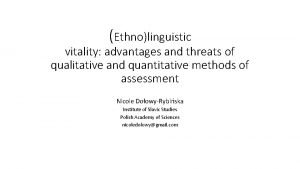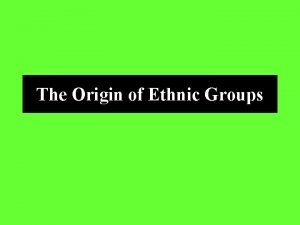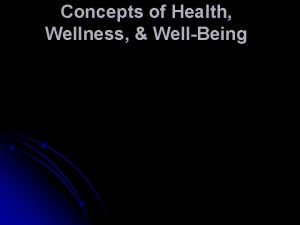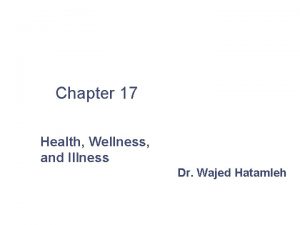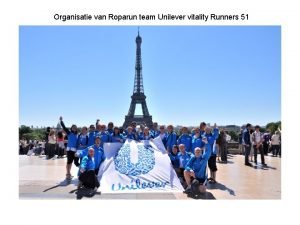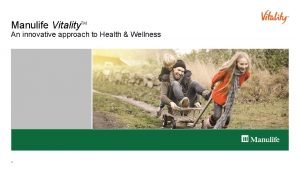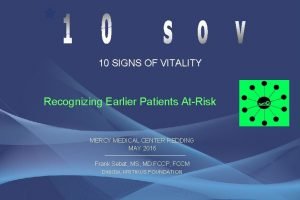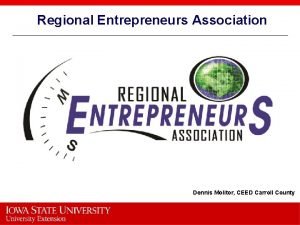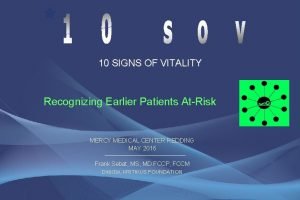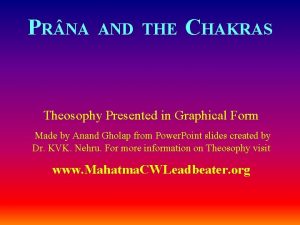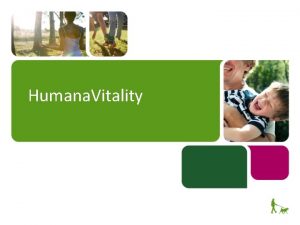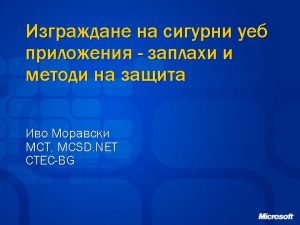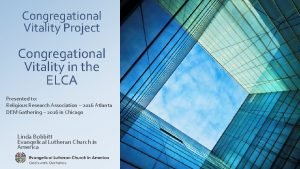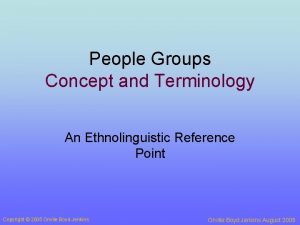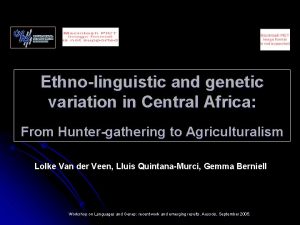Ethnolinguistic vitality advantages and threats of qualitative and











- Slides: 11

(Ethno)linguistic vitality: advantages and threats of qualitative and quantitative methods of assessment Nicole Dołowy-Rybińska Institute of Slavic Studies Polish Academy of Sciences nicoledolowy@gmail. com

Level 0 Label Description International The language is widely used between nations in trade, knowledge exchange, and international policy. 1 National The language is used in education, work, mass media, and government at the national level. 2 Provincial 3 Wider Communication 4 Educational 5 Developing 6 a Vigorous 6 b Threatened 7 Shifting 8 a Moribund The language is used in education, work, mass media, and government within major administrative subdivisions of a nation. The language is widely used in work and mass media without official status to transcend language differences across a region. The language is in vigorous oral use, and this is reinforced by sustainable transmission of literacy in the language in formal education. The language is vigorous and is being used in written form in parts of the community though literacy is not yet sustainable. The language is used orally by all generations and the situation is sustainable. The language is still used orally within all generations but there is a significant threat to sustainability because at least one of the conditions for sustainable oral use is lacking. The child-bearing generation can use the language among themselves but they do not normally transmit it to their children. The only remaining active speakers of the language are members of the grandparent generation. 8 b Nearly Extinct The only remaining speakers of the language are elderly and have little opportunity to use the language. 9 Dormant 10 Extinct There are no fully proficient speakers, but some symbolic use remains as a reminder of heritage identity for an ethnic community. No one retains a sense of ethnic identity associated with the language, even for symbolic purposes.

UNESCO – assessing vitality of a language 1. Inter-generational transmission: from no speakers existing any longer (grade 0) to language used by all age groups (grade 5); 2. Absolute number of speakers: the total number of speakers of a language; 3. Proportion of speakers within the total population: from no speakers (grade 0) to all members of the community are speakers of the language (grade 5); 4. Trends in existing language domains: where and with whom is the language used, and for what range of topics. The more consistently and persistently the language is used, the stronger the language is. Ideally, a language is used in all domains (universal use, grade 5). 5. Response to new domains and media: the degree of responsiveness of a language to new domains and new media; ideally, a language is used in all new domains. 6. Materials for language education and literacy: the extent to which written material is available and used in formal education. Scores are from 0, if no orthography available to the community, to 5, if there is an established orthography, literacy tradition with grammar, dictionaries, texts, literature, and everyday media. Writing in the language is used in administration and education. 7. Governmental and institutional language attitudes and policies, including official status and use: official external attitudes, not restricted to institutional protection. Grades range from the prohibition of speaking minority languages (grade 0) to official protection (grade 5). 8. Community members’ attitudes toward their own languages: this factor addresses the attitudes of community members towards the language. The more positive their attitudes are and more pride they have in language and traditions, the stronger the language is. 9. Amount and quality of documentation: the availability of historical and contemporary material, if any.

COD (Grin and Vaillancourt) For language to be used three conditions must be met: • Capacity: people must be capable of using a language; the capacity is treated here in subjective terms so it is the speaker’s confidence in their competences to use the language that is being assessed. • Opportunity: the knowledge of a language is not sufficient for the language to be used. Speakers have to have also an opportunity to use it. Opportunity depends on one hand, on the existence of a speech community and the level of language transmission; and on the other hand, on the existing institutional arrangements (legislation, regulations at schools or workplaces, etc. ) that allow for, support or prohibit the official and/or public use of the language. • Desire: the speakers’ wish and readiness to use the language, also reflected in attitudes and in their emotional reactions to the use of the language; It is here that the consequences of linguistic trauma and influences of language ideologies are the most important.

Why to measure ELV? (Ethno)linguistic vitality assessment can be used as an important tool in the language revitalization process. • It can serve both decision-makers, language policy planners in taking a decision where directing financial and political support in an appropriate way (to help the speech community to maintain their language and not only to make a political gesture) and to stakeholders to understand what risk the language is facing. The results can also help individuals, language users or potential users to understand their linguistic situation and to decide what language to speak with their children and in different situations. • BUT: these prognostics themselves have an influence on the endangered language condition! This is crutial from the point of view of language revitalization processes.

Ethnolinguistic vitality • A group's ability to maintain and protect its existence in time as a collective entity with a distinctive identity and language. • A language exists in correlation with a community and not as an object that can be observed in isolation (= ESSENTIALIZATION OF A LANGUAGE!). • Serves not to show the current condition of a given language/predict its future but most of all to help to identify those areas in the maintenance and use of a language that need particular attention and support. • Vitality should be assessed in relation with the notion of identity. • Vitality scales show some tendencies but whether a community disappear or survives depends on a number of individual decisions and complex circumstances that may influence these decisions. It concerns both language and collective identity. • Any research can influence negatively/positively people’s language decisions and language attitudes.

Problems with researching language minorities: • What does it mean a “speech community”? • What does it mean a “speaker”? (semi-speaker, potential speaker, new speaker. . . ) • What does it mean to “use” a language? • What is the relations betwwen language and identity? Ø Individual Ø Collective

Personal experience • Reseach on ethnolinguistic vitality of two groups in Europe that are using regional language – Kashubian in Poland Piedmontese in Italy: ØThe sample – different approaches based on field experiences and relations with the community; ØThe sample – age, sex, education level; ØThe questions – language practices, language attitudes, intergenerational transmission, awareness, language trauma. ØThe quantitative research – surprising results; ØThe field: direct contact with people and its influence on understanding the problem (especially what concerns language trauma)

Quantitative methods of assessment Observing language practices; Talking with people; Trying to understand their perspective; The language should not be essentialized! Finding out what is the relations between the language use and ethnolinguistic vitality – it may mean different things in different communities; it may mean different things for different groups (age, sex, social classes) within a community; it may mean different things from the point of view of language activists and people who suffered because of language trauma, etc. • May serve to show particular mechanisms and allow further analysis but will not be representative for the community at large. • • •

Quantitative methods of assessment • Scales of language endangerment, ethnlinguistic vitality; • Language exists through people that are using it; • Its functions (with relation to identity, wealthbeing, security etc…) may change over the time; • Questionnaires – the problem of finding the representative sample; • Questionnaires – the problem of finding the right questions; • To what extent are the questions universal? • What works in the case of one community may fail with another; • There is a need of a pilot qualitative studies before any questionnaire serving for quantitative research may be used.

Ethnolinguistic vitality • To provide ethnolinguistic vitality assessment we need to know the sociolinguistic, cultural and historical context of a speech community. • Assessing ethnolinguistic vitality should be based on research both quantitative and qualitative research. • The results must be provided with a deep analysis of what circumstances could influence responses of speech community members. ØDirect and in-depth contact with respondents is needed at least on the level of constructing the questionaire.
